The Sandy Bridge Preview
by Anand Lal Shimpi on August 27, 2010 2:38 PM ESTSandy Bridge Integrated Graphics Performance
With Clarkdale/Arrandale, Intel improved integrated graphics by a large enough margin that I can honestly say we were impressed with what Intel had done. That being said, the performance of Intel's HD Graphics was honestly not enough. For years integrated graphics have been fast enough to run games like the Sims but not quick enough to play anything more taxing, at least not at reasonable quality settings. The 'dales made Intel competitive in the integrated graphics market, but they didn't change what we thought of integrated graphics.
Sandy Bridge could be different.
Architecturally, Sandy Bridge is a significant revision from what's internally referred to as Intel Gen graphics. While the past two generations of Intel integrated graphics have been a part of the Gen 5 series, Sandy brings the first Gen 6 graphics die to market. With a tremendous increase in IPC and a large L3 cache to partake in, Sandy Bridge's graphics is another significant move forward.
Is it enough to kill all discrete graphics? No. But it's good enough to really threaten the entry level discrete market. Take a look:
Batman: Arkham Asylum

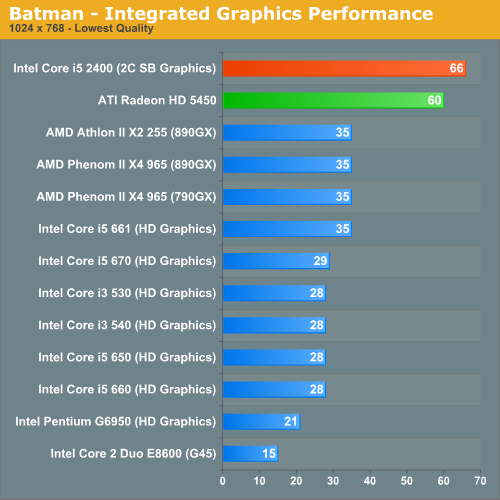
It's unclear whether or not graphics turbo was working on the part I was testing. If it was, this is the best it'll be for the 6 EU parts. If it wasn't, things will be even faster. Comparisons to current integrated graphics solutions are almost worthless. Sandy Bridge's graphics perform like a low end discrete part, not an integrated GPU. In this case, we're about 10% faster than a Radeon HD 5450.
Assuming Sandy Bridge retains the same HTPC features that Clarkdale has, I'm not sure there's a reason for these low end discrete GPUs anymore. At least not unless they get significantly faster.
Note that despite the early nature of the drivers, I didn't notice any rendering artifacts or image quality issues while testing Sandy Bridge's integrated graphics.
Dragon Age Origins
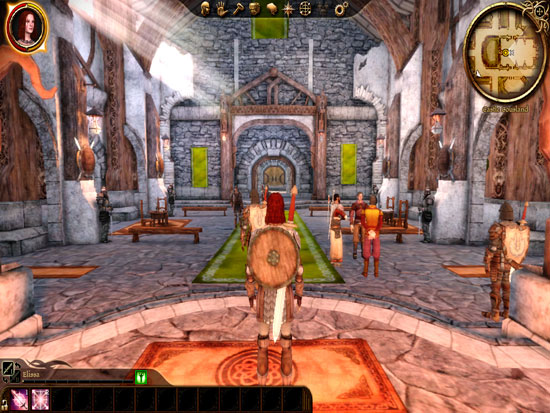
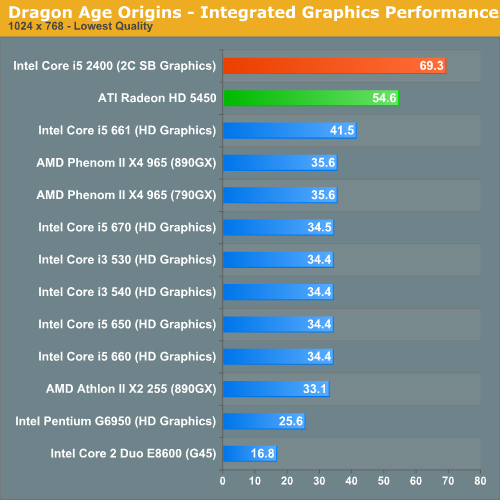
The Sandy Bridge advantage actually grows under Dragon Age. At these frame rates you can either enjoy smoother gameplay or actually up the resolution/quality settings to bring it back down to ~30 fps.
Dawn of War II
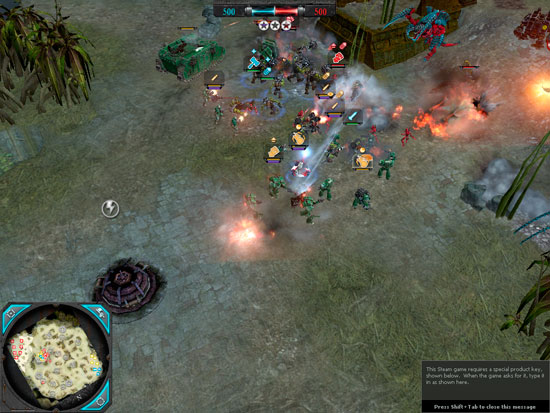
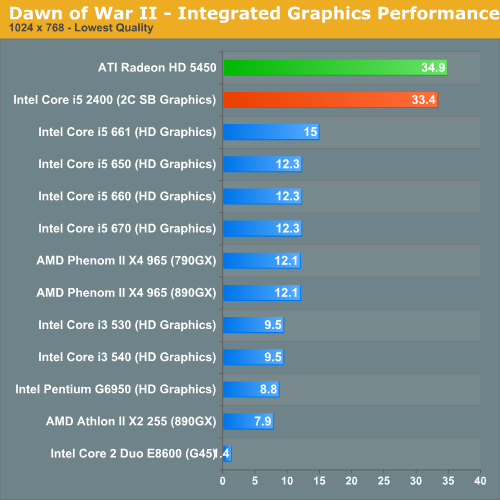
It's not always a clear victory for Sandy Bridge. In our Dawn of War II test the 5450 pulls ahead, although by only a small margin.
Call of Duty Modern Warfare 2
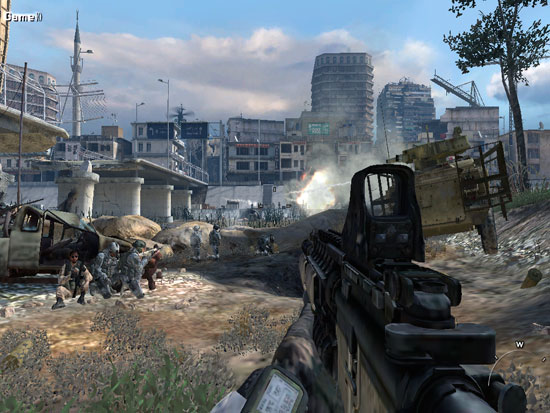
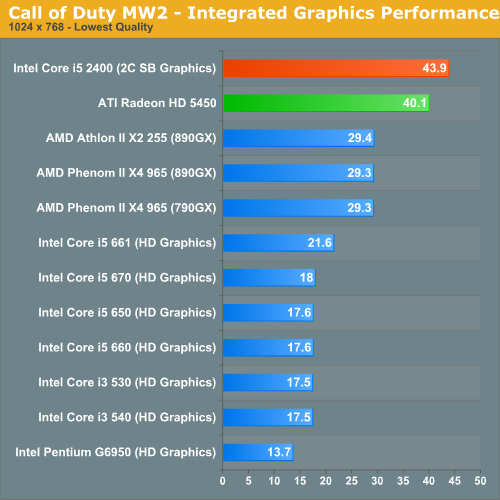
Sandy is one again on top of the 5450 in Modern Warfare 2. Although I'm not sure these frame rates are high enough to really up quality settings any more, they are at least smooth - which is more than I can say for the first gen HD Graphics.
BioShock 2
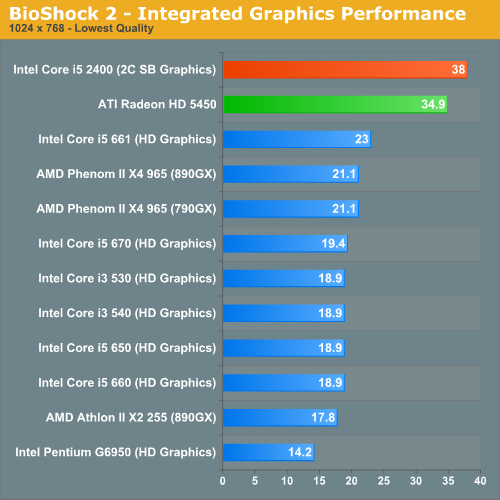
Intel promised to deliver a 2x improvement in integrated graphics performance with Sandy Bridge. We're getting a bit more than that here in BioShock 2.
World of Warcraft
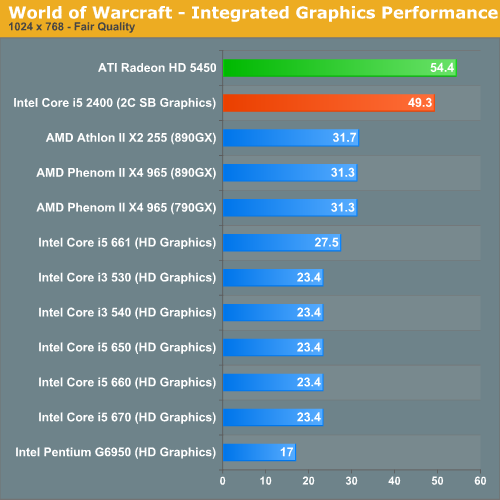
World of Warcraft is finally playable with Intel's Sandy Bridge graphics. The Radeon HD 5450 is 10% faster here.
HAWX
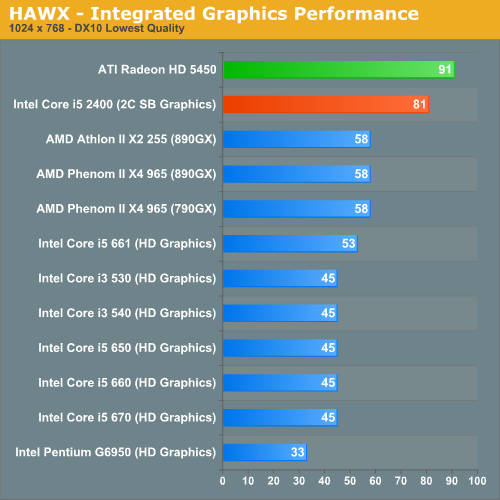
Sandy Bridge Graphics Performance Summary
This is still a very early look. Drivers and hardware both aren't final, but the initial results are very promising. Sandy Bridge puts all current integrated graphics solutions to shame, and even looks to nip at the heels of low end discrete GPUs. For HTPC users, Clarkdale did a good enough job - but for light gaming there wasn't enough horsepower under the hood. With Sandy Bridge you can actually play modern titles, albeit at low quality settings.
If this is the low end of what to expect, I'm not sure we'll need more than integrated graphics for non-gaming specific notebooks. Update: It looks like all notebook Sandy Bridge parts, at least initially, will use the 12 EU IGPs. Our SB sample may also have been a 12 EU part, we're still awaiting confirmation.










200 Comments
View All Comments
Touche - Friday, August 27, 2010 - link
And the naming...OMG!There will be i7 processors that require three (3 !!!) different sockets! Maybe even 4 when 2011 comes. Intel can't get their naming right for quite some time now, but they've outdone themselves this time.
ereavis - Monday, August 30, 2010 - link
Processor names really should mean something, even if AMD and Intel don't agree. It's annoying that I have to wikipedia a processor (or memorize a thousand processors) to know what it is. We are still getting quotes for three year old Opterons and Xeons (that we're using as desktops no less), those only add to the annoyance.What ends up happening - good for Intel bad for technology advancement - is non IT type people buying computers are buying DDR2-667 based three-year old desktop processors.
BSMonitor - Friday, August 27, 2010 - link
Ummm, but Bulldozer comes with AM3-r2... Just a sketchier way of saying new MB needed.At least this new Intel isn't trying to BS you. Significant revisions to the architecture require different pin layouts/counts... It is inevitable with processor evolution.
Touche - Friday, August 27, 2010 - link
Actually, it should be AM3 compatible:http://www.tomshardware.com/reviews/bulldozer-bobc...
Even if it's not, AM2/AM3 lasted quite some time.
"At least this new Intel isn't trying to BS you. Significant revisions to the architecture require different pin layouts/counts... It is inevitable with processor evolution."
They know in advance what they need and could design a socket to support multiple processors. And i7/i5/i3 definitely don't need different ones.
BSMonitor - Friday, August 27, 2010 - link
"Even if it's not, AM2/AM3 lasted quite some time."Not all AM2 processors were compatible with AM2+ MB or vice versa, not all AM3 processors compatible on AM2+ MB.
It's still 3 different sockets.
Marketing buddy, marketing.
By the time 1366 is replaced, it will have been on the market for 4 years.
stmok - Saturday, August 28, 2010 - link
Eh, no its not. Bulldozer does NOT work with non-AM3+ mobosAMD engineers made a decision not to make it backward compatible for three reasons.
(1) No one but enthusiasts upgrade their CPUs. People in the real world upgrade their whole computer.
(2) Bulldozer introduces new features that won't work with existing Socket AM3 mobos. (Isn't it bloody obvious when they have to introduce a new socket specification?)
(3) It would cost more money and delays if they were to make a backward compatible version of Bulldozer.
As a result, they made a compromise:
You can take your existing AM3 CPU to AM3+ mobos, while you wait for Bulldozer to arrive. BUT, you can NOT upgrade your existing AM3 based system to Bulldozer.
Simply put...
AM3+ CPU and AM3+ mobo = OK
AM3 CPU and AM3+ mobo = OK
AM3+ CPU and AM3 mobo = Sorry. No.
So it doesn't matter if AMD "Bulldozer" or Intel "Sandy Bridge". You will need a new mobo.
Ard - Friday, August 27, 2010 - link
AMD seriously has their work cut out for them with Bulldozer. The lowest end Sandy Bridge processor absolutely trounced the competition. It's insane what Intel is pulling off here, especially in the integrated graphics arena. Really makes me hope Larrabee comes back as a discrete product in the next few years.dgz - Saturday, August 28, 2010 - link
poor kid, you don't realize 2400 is not nearly lowest end.Finally - Sunday, August 29, 2010 - link
Doesn't that make him a "(filthy) rich kid"?Quodlibet - Friday, August 27, 2010 - link
- based on the shown roadmap, the replacement for the i5 760 is actually the i5 2500(K).- i7 will have even better performance with 8 MB L3 Cache and higher graphics turbo. So there is even more performance potential in the SandyBridge die that Intel could unlock for lower SKUs if needed.